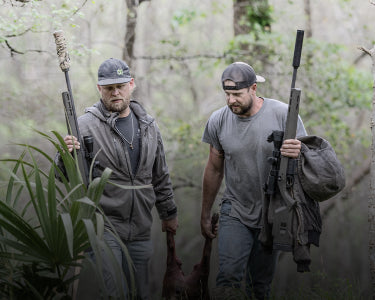“I guess all the little pops and bangs of the firing range just got boring after awhile,” that line from a Fallout New Vegas NPC named Pete stuck to me after so many trips to the range began to feel repetitive. I felt that shooting at static targets was simply not as fun nor as realistic as what it would be like to be in a real gunfight. That’s when I decided to try competition shooting.
Few things will humble a shooter faster than being in a falling steel run and gun competition with a bunch of SWAT operators and active military shooting 5x5” plates at 20 yards. Accuracy on a range involves taking your time with every shot, and does not translate into accuracy on a live fire course with dynamic movement. Some might shoot better under pressure, but others might be so nervous they shoot watermelon-sized groups at five yards.
Fortunately, I entered my first competition with a couple of others who weren’t new to shooting, but were new to competitions, with the only one of us who wasn’t new being Chris French, Sightmark’s social media manager. As they say, it’s better to suck with others than suck alone. (I don’t know if anyone actually says that, and if they don’t, they should.) As expected, we didn’t come out on top, but we put our heads together and analyzed what we did right and what went so wrong so that hopefully, if you find yourself in our shoes, you’ll learn from our mistakes.
Pre-Match Expectations
Going into our first shooting competition, we had pretty low expectations. Like most beginners, we were mainly there to figure out what we needed to work on. A lot of us were just expecting to lose and learn. Nobody really thought they’d be standing on the podium after their first match – if there was even going to be a podium. It was more about coming away with the knowledge of where we were lacking—kind of like a trial by fire. Honestly, failing fast was part of the plan; in general, we just wanted to absorb as much as we could on the fly and see how we stacked up.
The Most Surprising Thing
One of the biggest surprises from the competition came when one of us ended up scoring more A's than anyone else, completely surpassing his own expectations. Another shooter was caught off guard by performing his best on the very first stage—despite going in cold with zero experience, he somehow shot better before warming up than in the later stages.
The diversity in skill levels also stood out. The competitors ranged from highly skilled professionals to those just starting out, with little in between. It became clear that there was no "average" shooter in the mix. Perhaps the most surprising observation came from someone who noted that you couldn’t tell who the best shooter was just by looking at them. Before the competition started, it was anyone’s game.
Challenges Faced During Your First Shooting Competition
The challenges faced during the competition were varied but revealing. For some, speed and footwork proved to be the toughest obstacles, with moving quickly and maintaining accuracy being harder than expected. Another common issue was trigger control, with one competitor struggling to pull the trigger smoothly and reacquire the target after each shot, especially during recoil. Running short distances and then immediately reacquiring the target also turned out to be a difficult task. This is where red dot sights like the Sightmark Mini Shot M3 Solar truly shined, showing their advantage over iron sights. One of us ran a soon-to-be released closed emitter red dot from Sightmark just to put it through its paces, and the optic proved itself well, landing him in the top 10 scorers of his division.
Many of the other shooters had problems such as shooting unfamiliar guns that they borrowed from friends, guns that ran only iron sights, or used firearm platforms that could not be reloaded quickly or magazines that simply didn’t want to function. These were great mistakes to have in a competition, because having them happen in a real firefight would be catastrophic.
Issues with Equipment and Gear
When it came to equipment, experiences were mixed. Some competitors didn’t face any issues, with one stating his gear and ammo performed perfectly—any shortcomings came down to his own skill. However, the drum magazine I used was a different story. Apparently, depending on the firearm, the larger one’s magazine capacity is, the higher the chance of a jam. It seems painfully obvious now, but the balancing act between the spring, ammo, and magazine housing often collapses when there’s too much ammunition for the spring to feed reliably, proving that bigger isn’t always better.
The author experiences a critical malfunction with his drum magazine.
For others, there was no equipment failure, just the realization that competition-specific gear exists for a reason. It became clear that having the right tools can make all the difference in high-stakes scenarios.
What We’d Do Differently Next Time
When we compete again, we’ll take a slightly different approach. First and foremost, dry firing practice would be a priority—especially from awkward positions. Many of us realized the importance of getting more rounds downrange in general. One competitor felt that running a stock Glock with basic magazines and no optic didn’t do him any favors, and next time he’d opt for a red dot and magazine extensions. I found that while my Sightmark Mini Shot M3 Solar performed flawlessly on my PCC, my sling and drum magazine didn’t hold up as well, and I’ll choose more reliable attachments next time. In the end, the consensus was simple: dry fire more, shoot more, and, well… try not to suck.
Advice for Your First Shooting Competition: Takeaways & Tips
For anyone looking to compete in their first shooting competition, the advice is simple: just do it. No amount of reading articles, watching videos, or practicing on a static indoor range will truly prepare you for the real thing. Dry fire practice is crucial—keep at it until your trigger pull is smooth and the act of shooting becomes second nature. Be mindful of safety, go in with zero ego, and be ready to learn. Failure is inevitable, but that’s part of the process. One thing everyone agreed on: don’t wait until you’re “ready” because you’ll never feel fully prepared. Just jump in and learn on the go.
As for lessons learned? Pacing turned out to be a key takeaway. Some shooters realized how quickly accuracy fell off beyond 25 yards, while others saw their trigger pull inconsistency rear its head under pressure. Planning was another important lesson—having a strategy for each stage and sticking to it made a big difference. The competition made it clear where each shooter’s weaknesses lay, giving us all the chance to research, practice, and come back stronger for the next round.
Have a great outdoor adventure story? Share it with us! Accepted stories will receive a 20% discount code.
Frequently Asked Questions
What inspired the author to try competition shooting?
The author was inspired to try competition shooting because shooting at static targets at the firing range felt repetitive and not as fun or realistic as what it would be like to be in a real gunfight.
What is one key difference between accuracy on a range and accuracy on a live fire course with dynamic movement?
Accuracy on a range involves taking your time with every shot, while accuracy on a live fire course with dynamic movement requires shooting under pressure and while moving.
What was the author's mindset going into their first shooting competition?
The author had low expectations going into their first shooting competition, mainly focused on learning what they needed to work on and not expecting to win or be on the podium.
What was one of the most surprising things the author experienced during the competition?
One of the biggest surprises was when one of the shooters scored more A's than anyone else, surpassing his own expectations. Another surprise was a shooter performing his best on the very first stage despite having zero experience.
What observation was made about the skill levels of the competitors in the shooting competition?
The competitors ranged from highly skilled professionals to those just starting out, with little in between. It was noted that there was no 'average' shooter in the mix, and you couldn't tell who the best shooter was just by looking at them.
What were some of the challenges faced by participants during their first shooting competition?
Participants faced challenges such as speed and footwork, adjusting to shooting under pressure, and adapting to dynamic movement during the competition.





1 comment
There was a time when I enjoyed it… many years ago. Working class folks with LIMITED time and money for practice and occasional competition. You would win this month, and maybe I would win next month. Well that is long gone. The friendliness has been replaced by ruthlessness. T-shirts and blue jeans gave way to jerseys with manufacturers/sponsors names on them and shorts. Guys that shoot 52 weekends a year, 3 times during the week, and in between sit at a reloading bench. No production or stock service pistols. All carry optics, pistol caliber carbines, and unaffordable “John Wick” guns. Unfortunate to say the least. If you can enjoy it, drive on.